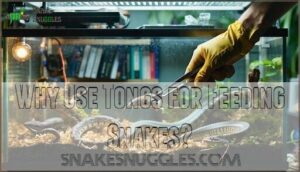This site is supported by our readers. We may earn a commission, at no cost to you, if you purchase through links.
 Learning how to feed a snake using tongs transforms you from nervous beginner to confident keeper.
Learning how to feed a snake using tongs transforms you from nervous beginner to confident keeper.
You’ll grip the prey firmly with 12-18 inch feeding tongs, present it at your snake’s eye level, and gently wiggle it to trigger their strike response.
The technique protects your fingers while mimicking natural prey movement—no more worrying about mistaken identity during feeding time.
Start with thawed prey at body temperature, move slowly to avoid startling your snake, and maintain steady pressure on the tongs until they’ve secured their meal.
Master this method and you’ll discover why experienced keepers swear by specific tong techniques that turn even the pickiest eaters into enthusiastic feeders.
Table Of Contents
- Key Takeaways
- How to Feed a Snake Using Tongs?
- Why Use Tongs for Feeding Snakes?
- Selecting The Right Snake Feeding Tongs
- Preparing for Tong Feeding Your Snake
- Step-by-Step Guide to Tong Feeding Snakes
- Troubleshooting Common Tong Feeding Issues
- Frequently Asked Questions (FAQs)
- How do I choose the right snake feeding tongs?
- Are snake feeding tongs worth it?
- How do you use a snake Tong?
- How do you feed a snake?
- How do you clean a snake feeding Tong?
- Why do snakes eat tongs?
- How do I feed my snake with tongs?
- How to use a snake tong?
- Do snake tongs work?
- How do you properly feed a snake?
- Conclusion
Key Takeaways
- You’ll protect yourself from dangerous snake bites by maintaining 12-18 inches of safe distance between your hands and those lightning-fast fangs during feeding time.
- You’ll trigger your snake’s natural hunting instincts by using tongs to wiggle and move thawed prey at eye level, mimicking wounded rodent behavior that encourages reluctant eaters to strike.
- You’ll need to warm frozen prey to 98-100°F before feeding to activate your snake’s thermal sensors and create the body temperature that triggers their feeding response.
- You’ll master the technique by gripping prey firmly behind the shoulders with steady pressure, presenting it slowly to avoid startling your snake, then releasing gradually once they’ve secured their meal.
How to Feed a Snake Using Tongs?
When you’re ready to feed your snake with tongs for snakes, you’ll master both safety and precision.
This feeding technique keeps dangerous fangs at arm’s length while mimicking natural prey behavior. Choose appropriate feeding tools based on your snake’s size and temperament.
Warm pre-killed prey to body temperature, then use gentle wiggling motions to trigger your snake’s hunting instincts. Snake behavior responds well to realistic movement patterns.
Once your serpent strikes, slowly release the meal. This method reduces bite risk by 90% while supporting proper snake nutrition.
Regular tong maintenance guarantees lasting performance and safety. Using the right safe snake tongs is vital for a stress-free feeding experience.
Why Use Tongs for Feeding Snakes?
Feeding your snake with tongs isn’t just safer—it’s smarter. You’ll protect yourself from accidental bites while encouraging natural hunting behaviors that keep your snake healthy and engaged.
Safety Benefits for Handler
With tongs, you’ll create a protective barrier between yourself and your snake, keeping you safely outside the striking zone.
Tongs transform feeding time from a risky gamble into controlled precision—your hands stay safe while your snake gets dinner.
Handler Protection becomes effortless when you maintain that vital Safe Distance—typically 12+ inches from those lightning-fast fangs.
Using proper snake handling tools is essential for a safe experience.
- Peace of mind: No more white-knuckle feeding sessions wondering if today’s the day you get tagged
- Clean conscience: Your snake stays stress-free when you’re not invading their personal space
- Steady hands: Confident feeding means better technique and happier reptiles
- Smart investment: One bite prevented pays for a lifetime of tongs
Simulating Natural Prey Movement
One moment you’re safely outside striking range, the next you’re orchestrating a masterpiece of predation. Using tongs for feeding lets you simulate movement that awakens your snake’s deepest hunting instincts.
You’re not just dropping dead prey—you’re breathing life into it through controlled motion. Mastering proper feeding techniques is essential for a successful feeding experience.
Master these snake feeding techniques to trigger natural hunting responses:
| Movement Pattern | Snake Response |
|---|---|
| Gentle wiggling motion | Heightened visual focus |
| Brief pauses followed by movement | Builds anticipation and strike readiness |
| Slow retreat when snake approaches | Triggers immediate pursuit instinct |
Your tong handling transforms frozen prey into convincing live bait. The key lies in reading your snake’s body language and adjusting prey movement accordingly, which is crucial for a successful feeding and to trigger the natural hunting responses in your snake, creating a convincing live bait experience.
Reducing Risk of Accidental Bites
Beyond natural prey movement lies the cornerstone of safe snake feeding: bite prevention.
Tongs create a protective barrier between your hands and those needle-sharp fangs. Snake behavior becomes predictable when you’re outside striking distance.
This risk minimization approach transforms feeding from a nerve-wracking gamble into controlled precision.
Your feeding techniques improve dramatically when accidental bites aren’t clouding your judgment with fear.
Maintaining Proper Hygiene During Feeding
Hand washing before and after feeding snakes safely prevents bacterial transfer between you, prey, and your snake.
Tongs eliminate direct contact during prey handling, reducing contamination risks.
Clean your feeding tools after each session for maximum hygiene.
Store frozen prey properly to maintain food safety standards.
Regular enclosure cleaning paired with proper feeding techniques creates a healthy environment that supports disease prevention and keeps your snake thriving.
Encouraging Reluctant Snakes to Eat
Picky eaters happen even with snakes – you’re not alone here.
Tong technique transforms your approach by mimicking natural prey variety movements that trigger instinctual responses.
Snake appetite often improves when you simulate live prey behavior, making reluctant eaters more likely to strike.
Understanding refusal reasons helps you adjust your feeding tricks and timing for better results.
Recognizing snake feeding issues is vital to addressing appetite loss in pet snakes.
Selecting The Right Snake Feeding Tongs
Choosing the right feeding tongs can make the difference between a smooth feeding session and a stressful wrestling match with your snake.
You’ll want tongs that match your snake’s size, your comfort level, and won’t break when things get intense during feeding time, which is crucial for a successful feeding session with your snake.
Different Types of Snake Tongs
Now that you’ve grasped tong feeding benefits, let’s explore your tong materials options.
You’ll find snake feeding tongs crafted from various materials, each offering unique advantages for feeding snakes with tongs.
- Stainless steel tongs for reptiles – Built like tanks, these won’t bend under pressure
- Lightweight aluminum feeding clamps – Your arms won’t ache during longer sessions
- Rubber-coated tong handles – No slipping when things get intense
- Angled grip styles – Perfect for those tricky feeding angles
Choose wisely – your snake’s dinner depends on it!
Length Considerations for Various Snake Species
Now that you know your tongue types, picking the right length matters for both safety and success. Snake size and species variations determine your ideal tong length and feeding distance. A small corn snake needs different tools than a massive python.
Here’s your length lineup for different situations:
- 8-12 inches: Perfect for small snake species like hognose or baby ball pythons – keeps you safe without being clunky
- 25-40 inches: Your sweet spot for medium snakes like adult ball pythons and corn snakes
- 52-72 inches: Essential for large constrictors and aggressive species – maximum safety margins
- Species-specific needs: Arboreal snakes need lighter, longer tongs; ground dwellers work fine with shorter options
- Enclosure size: Cramped tanks call for shorter tongs; spacious setups allow longer reach
Match your feeding tongs to your snake’s striking distance plus extra room for comfort. Remember, prey size and snake temperament also influence your choice. When selecting tongs, consider the importance of safe feeding practices to guarantee a stress-free experience for both you and the snake.
Grip Styles and Their Advantages
Different grip styles serve specific purposes when using snake feeding tongs.
Serrated edges grip slippery prey securely, while rubber-coated tips protect delicate snakes from injury.
Ergonomic handles reduce hand fatigue during extended feeding sessions.
Comfort grip designs with textured surfaces prevent slipping.
Angled handle styles provide better leverage and control.
Choose tong lengths and grip materials that match your snake’s size and temperament for effective snake tongs usage.
The quality of rubber grip tongs is vital for safe and efficient feeding, utilizing rubber grip materials, which are essential for the task.
Material Durability and Maintenance
Your tongs are your lifeline—choose materials that won’t fail when you need them most.
Tong Materials matter for long-term success:
- Stainless steel dominates with superior rust prevention and easy cleaning
- Rubberized tips protect your snake while maintaining secure grip strength
- Aluminum offers lightweight handle care but requires gentle use
- Plastic provides budget appeal yet demands frequent replacement cycles
Regular maintenance tips include thorough cleaning after each feeding session. Proper tongs maintenance extends lifespan substantially—inspect for damage, lubricate joints occasionally, and store in dry locations.
Durability tests show stainless steel snake feeding tongs outlasting alternatives by years, making them the smart investment for serious keepers. When selecting the right tongs, consider the benefits of stainless steel regarding durability and resistance to corrosion.
Budget-friendly Vs. Professional-grade Options
Budget snake feeding equipment doesn’t mean compromising safety.
Quality Budget Tongs start around $15-25, offering decent grip and durability for occasional use.
Professional Tongs ($40-80+) feature superior Tong Materials like medical-grade stainless steel, ergonomic handles, and replaceable tips.
Feeding Costs add up over time, so consider your Equipment Quality needs.
Casual owners often find budget options sufficient, while breeders benefit from professional-grade snake feeding tongs that withstand daily use.
When selecting tongs, consider the importance of budget tongs options to guarantee the best fit for your needs.
Preparing for Tong Feeding Your Snake
Proper preparation transforms tong feeding from a potentially stressful experience into a smooth, natural process for both you and your snake.
You’ll need to handle prey preparation, environmental setup, and timing considerations to guarantee your snake feeds safely and consistently.
Thawing Frozen Prey Properly
Proper prey thawing sets you up for feeding success.
Move frozen prey from freezer to refrigerator overnight—this slow method prevents bacterial growth while maintaining food safety.
Here’s your thawing game plan:
- Refrigeration method: Allow 2 hours for mice, 4-5 hours for rats at 41°F or below
- Cold water alternative: Submerge bagged prey, changing water every 30 minutes for faster results
- Safety first: Never use microwaves or room temperature—both create dangerous bacterial conditions
Warming Prey to Optimal Temperature
Once your frozen-thawed prey is properly thawed, warming it to ideal temperature becomes your next priority.
Think of it as bringing dinner back to life – your snake’s thermal sensors need that perfect 98-100°F sweet spot to trigger their feeding response.
Here’s your temperature control playbook:
- Submerge in warm water – Never use hot water that could cook the prey
- Monitor with digital thermometer – Guesswork leads to feeding failures
- Target 98-100°F range – This mimics natural body temperature perfectly
- Avoid microwaving completely – Uneven heating creates dangerous hot spots
Understanding the proper feeding temperatures is vital for a successful feeding experience.
Setting Up a Safe Feeding Environment
Now that your prey’s properly warmed, you’ll want to create the perfect feeding environment for your snake.
Clear any obstacles from the enclosure setup that might interfere with the feeding process. Your feeding area should be spacious enough for natural movement without decorations blocking the action.
Environmental control means checking that temperatures and humidity levels are ideal before starting. This snake feeding safety approach reduces stress for both you and your snake, making feeding snakes properly much easier when everything’s organized beforehand.
Ensuring Proper Snake Enclosure Conditions
Your snake’s enclosure becomes their dining room, so you’ll want everything perfect before mealtime arrives. Think of it as setting the stage for a successful feeding performance.
Temperature Control and Humidity Levels directly impact snake digestion and appetite. Your snake enclosure needs proper lighting cycles that match their natural rhythms. Fresh Ventilation Systems prevent stagnant air while maintaining ideal conditions. Regular Enclosure Cleaning eliminates bacteria that could interfere with feeding.
Here’s your pre-feeding checklist:
- Temperature gradients properly established with basking and cool zones
- Humidity levels within species-specific ranges using reliable monitoring
- Snake Hiding spots clean and positioned for post-meal security
- Comfortable environment free from excessive noise or disturbances
Timing Considerations for Feeding Sessions
Mastering your snake feeding schedule isn’t rocket science, but timing makes all the difference.
You’ll want to establish consistent feeding cycles every 7-14 days for adults, watching for snake hunger cues like increased activity or tongue-flicking.
Meal frequency depends on your snake’s age and species, while proper digestion time between meals prevents health issues.
Step-by-Step Guide to Tong Feeding Snakes
Now you’re ready to put your preparation into action with the actual feeding process. Proper technique guarantees both your safety and your snake’s successful feeding response.
Grasping Prey With Tongs Correctly
Your tong grip determines feeding success—hold prey firmly behind the shoulders without crushing it.
Position yourself at arm’s length for ideal handler position and snake safety.
Use steady pressure with your feeding technique, keeping the prey straight to trigger your snake’s natural strike response effectively.
Presenting Food to Different Snake Species
Positioning matters when presenting prey to your snake species.
Each type has evolved specific hunting strategies that you’ll need to respect during feeding sessions.
Here’s how to match your approach to your snake’s natural behavior:
- Terrestrial species (corn snakes, ball pythons) prefer prey offered at ground level
- Arboreal species (green tree pythons) need elevated presentation near branches or perches
- Nocturnal feeders respond better during evening hours when their hunting instincts peak
Understanding these species-specific preferences improves feeding success rates dramatically.
Mimicking Natural Prey Movements
Now you’ll transform that thawed prey into irresistible snake bait.
Master the twitch and flick technique by gently wiggling your snake feeding tongs in short, erratic bursts.
This prey movement triggers your snake’s natural hunting instincts, stimulating appetite even in picky eaters.
Keep movements subtle—you’re mimicking a wounded rodent, not conducting an orchestra!
Encouraging Strike and Feeding Response
With natural prey movement down, you’ll trigger your snake’s strike reflex by positioning prey at head level.
Present the meal using snake feeding tongs to stimulate snake appetite through these Snake Strike Triggers:
- Gentle nose tapping awakens dormant hunting instincts
- Consistent wiggling mimics wounded prey vulnerability
- Proper temperature activates the Feeding Reflex
- Patient persistence overcomes feeding hesitation
This Prey Presentation technique transforms reluctant eaters into enthusiastic hunters.
Safely Releasing Prey Once Snake Engages
Once your snake’s strike response connects with the prey, gradually loosen your grip on the feeding tongs without jerking away.
This smooth prey release tips technique prevents startling your snake or damaging their teeth during engagement.
Safe snake feeding requires patience—let the snake feeding basics take over as your pet shifts from strike response to natural feeding behavior using tongs to feed, ensuring a safe experience.
Troubleshooting Common Tong Feeding Issues
Even experienced snake owners encounter feeding challenges when using tongs, but most issues have straightforward solutions.
You’ll find that understanding your snake’s behavior and adjusting your technique accordingly makes tong feeding much more successful, and this is crucial for experienced snake owners.
Dealing With Reluctant or Picky Eaters
Even the most cooperative snakes can develop finicky eating habits that’ll test your patience.
When your snake becomes a reluctant feeder, you’ll need specific feeding tricks to rekindle their appetite and restore normal eating habits.
- Temperature optimization – Warm prey to 98-100°F using warm water baths to trigger natural feeding responses
- Prey modification – Downsize by 20-30% or switch from white to natural-colored rodents for intimidated snakes
- Scent enhancement – Dip prey in sodium-free chicken broth or rub with preferred food for scent transfer
- Environmental adjustments – Increase humidity to 70-80% and provide multiple hiding spots to reduce stress
Addressing Food Striking but Not Eating
When your snake strikes at prey but won’t complete the meal, you’re witnessing classic food refusal behavior that’s actually quite common.
Check if your prey temperature matches body heat (98-100°F) since cold meals often trigger strikes without eating. Snake appetite can fluctuate based on shedding cycles, stress levels, or environmental changes.
Try adjusting feeding cues like wiggling motion or lighting conditions to stimulate natural strike triggers. Some snakes develop eating disorders from inconsistent routines, so maintain regular feeding schedules.
If your picky eater continues refusing meals despite proper snake feeding tongs technique, consider consulting a reptile veterinarian to rule out underlying health issues affecting feeding preferences.
Managing Aggressive Feeding Responses
Overzealous feeders can turn mealtime into mayhem, but you’ve got the tools to tame the beast. Aggressive feeding responses stem from heightened feeding triggers and snake temperament, making bite prevention your top priority through proper stress management.
When your snake transforms into a striking machine, longer snake feeding tongs become your best friend. These aggressive feeding responses require modified snake feeding methods that prioritize safety.
Handling snakes with tongs at extended distances reduces risk while addressing common snake feeding problems.
- Use 18+ inch tongs to maintain safe distance from aggressive strikers
- Move slowly and deliberately to avoid triggering defensive behaviors
- Create consistent feeding routines to reduce stress-induced aggression
Adjusting Technique for Different Snake Sizes
Your tong technique varies by snake size to guarantee safe, effective feeding.
Smaller snakes need shorter tongs with gentle movements, while larger species require longer feeding tools for safety.
Match your tong length to your snake’s striking distance – typically 12-18 inches for adults.
Adjust your grip strength based on prey selection and your snake’s feeding response intensity.
Transitioning From Hand Feeding to Tongs
Making the switch from hand feeding to tong feeding requires a methodical approach that prioritizes both handler safety and snake acclimation.
Your snake’s feeding shift doesn’t happen overnight, but these proven feeding techniques will help:
- Begin with tong introduction: Hold prey with tongs while your snake strikes, maintaining your usual hand feeding distance initially
- Gradually increase distance: Extend tong length over several feeding sessions as your snake adapts to the new feeding process
- Maintain consistency: Use the same feeding tongs and techniques each session until your snake fully accepts this safer feeding method
Frequently Asked Questions (FAQs)
How do I choose the right snake feeding tongs?
Choose tongs based on your snake’s size and temperament.
You’ll want at least 12-inch length for safety, stainless steel construction for durability, and rubber-coated tips for better grip without injuring your serpent.
Are snake feeding tongs worth it?
Absolutely – snake feeding tongs reduce bite risk by 90% compared to hand feeding.
They’re essential safety tools that maintain proper distance, encourage natural hunting behavior, and minimize stress for both you and your snake.
How do you use a snake Tong?
You’ll grip frozen prey behind its head using metal tongs.
Then wiggle it naturally to simulate movement.
Present the prey at your snake’s eye level, maintaining safe distance.
Encourage strikes through gentle, lifelike motions.
How do you feed a snake?
You’ll need to thaw frozen prey in the refrigerator overnight.
Then warm it to body temperature.
Using 12-inch feeding tongs, grasp the prey gently and wiggle it near your snake’s head to trigger their natural strike response.
How do you clean a snake feeding Tong?
After each feeding session, you’ll want to wash your tongs thoroughly with warm, soapy water to remove any bacteria or prey residue.
Rinse completely, then sanitize with rubbing alcohol or reptile-safe disinfectant before storing them properly, ensuring to remove any remaining residue.
Why do snakes eat tongs?
Snakes don’t actually eat tongs – they’re accidentally bitten during feeding when handlers move too quickly or present prey incorrectly.
This triggers the snake’s natural strike response toward the metal instead of food.
How do I feed my snake with tongs?
Warm your thawed prey to 98-100°F, then grasp it firmly with 12-inch tongs behind the head.
Present it near your snake’s head, wiggling gently to mimic natural movement and trigger the strike response.
How to use a snake tong?
Using tongs reduces snake bite risk by 90%.
Grip prey firmly behind the head, present it near your snake’s head level, and wiggle gently to trigger hunting instincts.
Release slowly once they strike.
Do snake tongs work?
Yes, tongs work exceptionally well for snake feeding. They reduce bite risk by 90% while maintaining safe distance and proper hygiene. You’ll trigger natural hunting instincts effectively.
How do you properly feed a snake?
Like conducting a symphony, you’ll orchestrate each feeding with precision and care.
Thaw frozen prey overnight, warm to 98-100°F, then grip firmly with 12-inch tongs.
Present near the snake’s head, wiggling gently to trigger natural strikes.
Conclusion
Nearly 80% of snake bite incidents during feeding occur when handlers use their bare hands instead of proper feeding tools.
Mastering how to feed a snake using tongs eliminates this risk while creating a stress-free experience for both you and your pet.
You’ll find that consistent tong feeding builds your confidence and establishes healthy feeding routines.
Remember to grip prey firmly, move deliberately, and maintain steady pressure throughout the process.
With practice, you’ll develop the technique that transforms feeding time from anxiety-inducing chore into smooth, predictable care routine.
- https://www.agfc.com/news/big-faker-eastern-hognose-is-arkansass-counterfeit-cobra/
- http://www.healthline.com/health/snake-bites
- https://icloverhunting.com/blogs/news/ensuring-safety-the-importance-of-snake-tong-in-handling-snakes
- https://www.africansnakebiteinstitute.com/articles/the-pros-and-cons-of-snake-tongs/
- https://talis-us.com/blogs/news/reptile-feeding-tongs-essential-tools-for-proper-reptile-nutrition



















